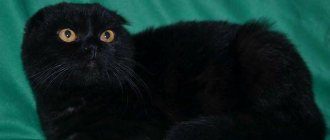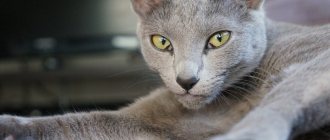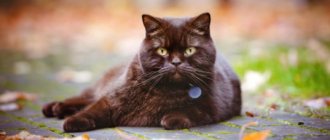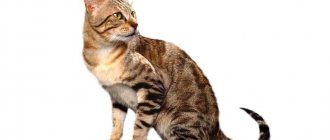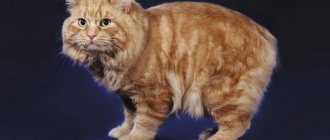Energy needs of a cat
Before looking for an answer to the question of what to feed your cat, you need to find out the quality characteristics of the food.
The diet should contain a certain set of useful elements that replenish energy expenditure and maintain skeletal muscles in good shape. A sexually mature individual outside the period of gestation and lactation requires about 75 kcal per kilogram of body weight. Feeding a cat requires special rules
The list includes the following elements (calculation is carried out per 1 kg of body weight):
- arginine - 0.38 g;
- protein - 6.3 g;
- valine - 0.34 g;
- histidine - 0.19 g;
- isoleucine - 0.38 g;
- leucine - 0.47 g;
- lysine - 0.57 g;
- tyrosine - 0.63 g;
- threonine - 0.28 g;
- tryptophan - 0.07 g.
The maximum proportion of organic substances falls on plant fiber, sugar and starch. They are an important source of energy and provide up to 70% of the calorie intake.
For your information! Cats are carnivores and their main diet is meat. Attempts to increase the proportion of plant components at the expense of meat can cause serious diseases.
Wet food is rich in many vitamins and microelements
TOP 4 best ready-made feeds
If the owner does not have the opportunity or time to prepare natural food for his pet, he can purchase ready-made diets. According to veterinary experts, the most suitable for Russian Blues are:
- IAMS CAT POUCH rich in Chicken. World-recognized leader in cat food. It is a completely balanced product, and therefore can be used as an independent dish. It has a pleasant strong smell and stimulates the animal's appetite. Sold as pieces of meat in sauce.
- Royal Canin Instinctive. It comes in the form of pates and jellies. Suitable for daily feeding of cats from one year old. Thanks to the carefully selected amount of calories, it can be used at different stages of the life of Russian Blue cats.
- Acana GRASSLANDS. One of the best dry food options for adults. Approximately 75% meat and 25% vegetables.
- Purina Pro Plan Dental+. Dry food intended for cats from one year of age. It looks like granules. Ideal for maintaining dental health.
Representatives of the breed must take yeast twice a year. Sometimes they are recommended calcium, vitamin or mineral complexes. Only a veterinarian can determine which supplements are suitable in a particular case, as well as what changes will need to be made to the animal’s diet. The health of your pet and its longevity depend on the balance of the diet and the correctness of the regime.
Also watch a video about proper nutrition of the Russian Blue cat:
Russian Blue is a popular cat breed in our country. Proper care, competent maintenance, balanced nutrition, regular consultations with a veterinarian, as well as preventive measures, allow the Russian Blue cat to remain healthy and active for many years.
Diet features
Typically, the frequency of meals for Russian Blue cats depends on their age. Information about this is presented in the table.
| Age, months | Daily norm, gr. | Frequency, once/day |
| 3 — 4 | 120 — 150 | 5 |
| 4 — 6 | 180 — 240 | 4 |
| 6 — 12 | 200 — 250 | 3 |
Important! Once adult animals reach one year of age, they can be switched to two meals a day.
As for the quality of the diet, attention should be paid not only to its complexity and balance, but also to variety . According to veterinarians and breeders who adhere to a holistic approach to animal nutrition, the best option is a combination diet. Industrial feed of the “super premium” and “premium” classes will provide a balance of nutrients, essential amino acids, vitamins and minerals.
Natural food (dietary meat, lean fish, fresh vegetables, dairy products) makes your diet varied, maintains a normal pH level, prevents dehydration and the development of allergic reactions.
Eating foods high in copper and iron can change the magnificent silver color of the coat, giving it a brown, rusty tint. Therefore, the following are excluded from the diet of the Russian Blue cat:
- seaweed;
- shrimps;
- shellfish;
- liver, including cod;
- beef;
- legumes;
- oatmeal.
You should also pay attention to the composition of vitamin and mineral complexes and avoid those that contain seaweed. Based on the standard requirements for the condition of the Russian Blue cat, the menu does not include whole milk and fatty fish so that the animal does not gain excess weight.
Place for a kitten in the house
Purchasing a Russian Blue kitten is hardly a spontaneous decision. Therefore, before the baby arrives in the house, his place must be arranged and everything necessary for maintenance and care must be prepared.
At least three stainless steel or earthenware bowls: short for wet food, medium for dry croquettes, deep for water.
A litter tray, or better yet two - one smaller one will be needed for the kitten in the first months of life, and the second one will be used by the kitten as an adult. As a rule, kittens, when leaving their first home, are already litter box trained and all that remains is to decide which brand of litter to use. It is quite possible to accustom a kitten to an empty tray with a grid - it is useful and hygienic: the filler granules will not fly away in all directions and be carried around the apartment by their paws. In this case, the task of neutralizing the odor is always solved by a cleanly washed tray.
Hygiene items - brushes and combs, a rubber brush for combing out dead hair, nail clippers, a suede cloth for polishing, a toothbrush for animals, the necessary set of pet products and towels for washing. The owner must take care of the cleanliness of all these accessories in the same way as his own. A Russian Blue cat should be accustomed to grooming from childhood, and then trimming its claws or another bath will not be a shock for either the animal or the person.
Toys are a mandatory and important component of the kitten’s socialization process. With equal pleasure, the little mermaid will chase both an ordinary bow on a braid and the beam of a laser pointer.
Therefore, what matters is not how expensive or technically advanced the toy is. The main thing is that it is not traumatic (breakable, cutting, heavy) and has a suitable size: a kitten that is too large will not be interested, a small one can be swallowed. Russian Blue kittens in their usual environment are usually very active, playful and do not lose these qualities with age.
Games help you hone your technique for moving gracefully through space.
A scratching post is also a familiar item for a nursery graduate. The owner has the choice of design and size - from a modest column covered with rope to a multi-level playroom complex - this absolutely necessary device.
A carrying bag is indispensable as a means of transport for visits to the veterinarian, trips and travel.
A bed is sometimes not considered a necessary item: about 90% of surveyed cat owners allow their pets to sleep in their bed. But still, the Russian Blue should have an individual place to sleep, to which the animal must be accustomed from childhood. “Put a piece of paper in the middle of a football field, and sooner or later a cat will lie on it”: purrs love to lie on something, be it the owner’s favorite designer blouse or a stack of freshly ironed linen. And Russian Blues are no exception.
To avoid such unpleasant surprises, you will need a crib or basket for the baby. Other useful items - harnesses for walking and swimming, a collar with an address medallion, warming and antistatic bedding - can be purchased later.
Cats use their sense of smell to a greater extent than their other senses to navigate unfamiliar environments. Having gotten used to the smell inherent in the owner and relating it to a calm environment, the baby will quickly get used to the new home and begin to enthusiastically explore the new space. There is no need to prevent this, but such educational excursions should not take place unsupervised.
The owner must use every opportunity for communication and joint games, not forgetting the words of encouragement for any, even the smallest, achievement of the baby. Very soon the kitten will begin to associate home and family with the most pleasant sensations - delicious food, love, a sense of comfort and security.
Breeding
One of the main rules of mating is to mate only with an individual of the same breed. Currently, there are many clubs for fans of this breed, so choosing a suitable partner is not difficult. Russian blue cats do not have any particular difficulties with mating. Representatives of this breed are too shy and calm to fight or argue with the cat. Usually mating takes place on the male's territory, so the cat's owner must worry about the trip. Cats reach sexual maturity at 1.5–2 years. After this, you can start looking for a partner. Sometimes, due to the lack of opportunity to find a Russian Blue cat, cats are bred with males of another breed, but this is highly not recommended.
a suitable cat can be found from the same breeder where the cat was purchased
Criteria for choosing a partner
In order to find a worthy partner for your cat, find out what nurseries/breeders there are in your city. Study the reviews of those who have already contacted these breeders. If nothing alerts you, start calling. You can ask any questions you may have by phone. If the nursery owner avoids answering any question, then perhaps he has something to hide. Once you have decided on a nursery, go to the desired address
Particular attention should be paid to the following nuances:
- appearance;
- pedigree;
- cat experience;
- documentation.
It is necessary to examine the appearance of the proposed male. The cat must be clean, without any deviations from the standard and without external damage (abrasions, bald spots, wounds). The animal must be active and look healthy. The cat must have a veterinary passport with notes on all vaccinations given. In addition, you can ask for the pedigree of the cat and its parents (if network). If there is a pedigree, the owner of the animal will offer it himself. Only with the help of this document can you understand that the cat is truly purebred. This will guarantee that the mating will produce beautiful blue kittens.
How often can a cat give birth?
To prevent the cat from getting sick, you need to control the frequency of births
Cats can give birth 3-4 times a year. But this usually happens during uncontrolled matings, when the animal leads a street lifestyle or has free access to the street. In addition, some (not very caring) breeders use the cat’s ability to give birth frequently for their own selfish purposes. But frequent childbirth can exhaust the cat, its health will weaken, and this can lead to the development of a number of female diseases. To prevent this from happening, you need to control the number of matings of the animal.
Interesting facts from the history of the breed
The true origin of blue Russian cats is still unknown for certain (not to be confused with the history of the breed). The most viable version is that the ancestors of this breed were gray cats that inhabited a wide range of northern Russia. Domesticated gray-blue cats were brought to Europe by Russian sailors from Arkhangelsk. Therefore, Russian Blue can also be called Arkhangelsk.
Among other breeds, at the world's first cat exhibition, organized in London in 1871, Arkhangelsk cats, the same Russian blue breed, participated in the “blue color” category. The main selection work to develop the breed was carried out by the Englishwoman Lady Cox. The first breeding cat of this breed was named “Diana”.
After World War II, there were almost no purebred Russian cats left in England, and for those that remained, it was impossible to find a pair. The breeders decided to resort to interbreeding, choosing Siamese cats of a similar color to produce offspring.
Natural nutrition
Natural feeding involves providing the cat with certain approved products.
4.1. Products for natural nutrition
The diet of a cat that eats natural food should include the following products:
- meat - beef; pork is prohibited. Meat should be given every day. Some veterinarians advise feeding raw frozen meat, others recommend boiling it;
- poultry meat. Boiled chicken, from which all the bones have been removed, can be given three or four times a week;
- chicken or beef by-products, such as lungs, liver, kidneys and heart. They, like meat, must be cooked or frozen. Can be given two or three times a week, liver only once;
- Boiled egg yolk – once or twice a week;
- Fermented milk products: kefir, fermented baked milk, yogurt, cream, sour cream can be given daily, and cheese - once a week;
- Fresh cottage cheese – once or twice a week;
- cereals – boiled rice, buckwheat, wheat. They must be mixed with meat in a 1:2 ratio and given several times a week;
- raw vegetables mixed with meat are given several times a week.
4.2. Features of natural feeding
Food prepared for a cat does not need to be salted. Food should not be given too cold or too hot; it should be at room temperature. If you take another portion out of the refrigerator, warm it up a little. Don't give your cat large pieces.
Once every two weeks you can give sea fish without bones, pre-boiled. River fish should not be given because it is infected with parasites. Contrary to popular stereotypes, fish is not the main cat’s diet; moreover, it can cause harm to the animal, so it can be given very rarely. In particular, it contributes to the development of urolithiasis, which is a fear of all cat owners. Castrated animals should not be given fish at all.
Adult cats are not given milk because they do not have the special enzyme necessary to digest milk. Its use can cause digestive upset in the animal.
Be sure to choose the optimal vitamin complex that is necessary for a natural diet.
Natural food for adult cats
If the owner decides to feed his pet “natural” food, then the menu should include the following products:
- Meat . All purebred representatives are big meat lovers, but it is recommended to completely exclude pork from their diet. Poultry meat is more suitable - turkey, chicken. Beef and veal can complement this list. Most vitamins are found in chilled raw meat. However, sometimes it can be boiled and stewed.
- Fish . Sea varieties are best suited. It must first be boiled and pitted. Frequency – once every 10 days.
- Offal . Can be used several times a week. Liver, heart, lungs, kidneys, tripe are useful for the cat’s body. It is better to give them raw.
- Seafood . From this category, only shrimp and shellfish are allowed. They must be boiled first. You should not give these products to your animal more than once a week.
- Dairy . Pasteurized milk with a fat content of up to 1.5%, sour cream with a fat content of up to 20%, fermented baked milk, kefir and natural (without additives) yoghurts are allowed.
- Eggs . Chicken eggs can only be given boiled, because raw eggs contain avidin, which destroys vitamin H. Quail eggs can be given both raw and boiled. Eggs are not given to a cat more than once every 10 days.
- Cereal products . Almost all varieties of grains, except sprouted ones, can be included in the diet. Pasta and baked goods do not provide any particular benefit to the animal, so they are not necessary.
- Vegetables . Products of plant origin are poorly absorbed by the Russian Blue cat's body. However, you should not completely exclude them from the diet. It is useful to give them to prevent vitamin deficiency. Zucchini, carrots, beets, and canned corn are suitable. The optimal volume of vegetables should be calculated as follows: 5 g of vegetables per 1 kg of cat weight.
It is forbidden to feed the Russian Blue cat sweets, confectionery, fruits, or dishes with spices.
Choosing a kitten, care and education
The kitten should be active, playful, but not fearful, aggressive or inhibited. Breed characteristics:
- The body is slender.
- The head may be gently rounded.
- The nose should be straight.
- The ears are wide and large.
- The limbs are strong and high.
- The tail is long, mobile, there are no creases.
- The fur is shiny, soft, thick, there are no white spots.
- Barely noticeable stripes may be present and will disappear with age.
- Pale green eyes (but yellow!), let's say a golden rim along the edge of the iris, it disappears over time. A kitten that is too small has gray-blue eyes; they become green by the 3-4th month, and sometimes by a year.
How to care
Russian Blue kittens are easily accustomed to the toilet and scratching post. It is recommended to purchase 2 toilets. They are placed in different corners of the bathroom or toilet room. These cats love elevations, so you can buy or make a house with several floors.
A box with soft, warm bedding can serve as a sleeping place. When the pet grows up, it can be placed on the windowsill. To prevent the kitten from climbing the curtains, make a vertical device - a “climbing frame” on the closet, nail a scratching post to the door jamb at full height. Make or buy toys: pieces of fur, mice, balls, candy wrappers, etc.
To care for the fur, buy a rubber brush (with small spikes). Brush your pet 2 times a week. Ventilate the room well so that the kitten feels good. Avoid drafts - this is dangerous for his health.
How to educate
Education must begin as early as possible. Proper handling of a kitten will affect future relationships
It is important to find a common language with him. Peculiarities of upbringing: you cannot shout, punish, especially beat. Talk to your pet calmly
Talk to your pet calmly.
If the kitten is naughty, take him in your arms and strictly say “No!” Look him in the eyes. Most often this is enough. As a last resort, you can spray water on it. If your pet starts playing late in the evening, when it’s time to go to bed, then you need to play with him. He will be tired and sleep soundly.
Preparation for the exhibition
Pay attention to the mental development of the kitten. It is necessary that he:
- was not afraid of people or other cats;
- did not show aggression;
- calmly endured trips in the car;
- was calmly in the exhibition cage.
The kitten should not be afraid when touched. You need to pick him up more often. Turning on the TV or radio will help you get used to loud sounds. At least 3 weeks before the exhibition, the pet must be dewormed and vaccinated.
Raising a Russian Blue
Russian Blue cats are so smart and so sensitive to a person’s mood that the process of raising them turns into pleasant friendly communication . It is very easy to explain to pets what can be done and what is unacceptable. Being too naughty, they understand perfectly well what will get away with them, and why the owner will be angry.
They have excellent learning abilities: for example, once they see a door or box open, Russian Blue cats will do it on their own. All these features must be used to prepare future champions. This is the only task that will require some effort on the part of the owner of a show class animal. Russian blue cats do not create any other problems.
This is interesting! Preparation for the ring includes not only constant high-quality care, but also the formation of psychological stereotypes and behavioral reactions of the cat. This needs to be done from the first months of your pet’s life.
Fear of people, display of aggression, nervous behavior in the exhibition cage can serve as reasons for the disqualification of an animal despite its highest breed qualities. By nature, Russian Blues are quite shy; they do not immediately get used to new surroundings and are wary of strangers.
Early socialization of the animal will help level out such traits: the kitten needs to be picked up more often, accustomed to loud sounds, being carried, traveling by car, and walking on a leash. All this will subsequently have a positive effect on the degree of adaptation to change and the behavior of the animal in an unfamiliar environment, and therefore will increase the chances of well-deserved success, recognition and rewards.
Russian Blue: feeding dry and wet food
The Russian Blue cat's diet consists of dry food and wet food.
Feeding the cat is determined as a percentage and it is important to maintain the proportions
Russian Blue cat: nutrition for adult cats and cats
In the diet of Russian Blue cats, dry food should make up no more than 70% of all feedings. The remaining 30% (or more) should be wet food (meat, dairy products, canned food, preserves, etc.).
Russian Blue: kitten nutrition
The diet of Russian Blue kittens includes no more than 30% dry food and 70% wet food. Gradually, a smooth transition occurs towards adulthood: part of the wet feeding is replaced with dry food.
Can Russian Blues have carrots?
Many people are interested in whether Russian Blues can eat carrots? - Yes, of course it is possible. Everyone knows that carrots contain a large amount of vitamins for the growth, development and activity of cats such as Russian Blues. If your Russian Blue cat eats carrots, that's great, but everything needs moderation, don't forget about it!
Feed your Russian Blue pets correctly and they will delight you with their beauty and activity for many years to come!
What will you learn from the article?
Do you know that the Russian blue cat is considered the pearl of Russian felinology? Selling kittens of this breed is popular all over the world. Before you get a pet, you need to know what food is best to feed your Russian Blue cat.
Russian blue cats are not picky about food at home. Their owners should remember several feeding rules:
- do not feed your pet from your table;
- wash food bowls daily;
- do not give ready-made economy class food;
- Make sure your cat always has fresh water.
Important! All recommendations for feeding the Russian Blue cat boil down to the desire to preserve its unique color. The cat's diet should not contain food containing seaweed, legumes, liver or shellfish.
Otherwise, the color may change to reddish.
This ban is not global, because the color change is temporary. However, this can negatively affect the “career” of show cats. Also, your pet should not be given whole milk and fatty fish.
The secret of the correct diet of the Russian Blue cat
What to feed a Russian Blue cat? The answer to this question will be 4 simple rules:
- do not feed your pet leftover food from your table: some foods can cause harm to health;
- Wash bowls after every meal: Russian Blues are very picky in terms of cleanliness;
- exclude economy class food (recommendation);
- Make sure that the animal always has clean water.
It is recommended to feed kittens up to 1 month of age with milk, gradually adding cheese and cottage cheese to the diet. It is important to remember that babies are given only natural products, without additives or flavorings. Starting from a month, lean meat is added to the kitten’s daily diet: chicken, turkey, beef, rabbit. You can give crushed yolk of a boiled chicken egg.
When the kitten is 2 months old, it is gradually introduced to dry food. To ensure that changes in the diet go unnoticed, it is better to pre-soak the granules in clean water.
Adult cats can eat ready-made food and eat natural products, as long as the diet includes amino acids, taurine and fats of animal origin.
Kitten Feeding Basics
The kitten's body is quite vulnerable, so the best nutrition during the first weeks of its life is mother's milk. About 30-40 days after birth, milk alone becomes insufficient for the kitten. At this age, it is recommended to introduce the first feedings.
Babies, unlike adult cats, are allowed to give slightly warmed (not higher than 40℃) cream or pasteurized milk with a fat content of 2.6-3.8%. Fermented milk products such as grated cheese and crushed cottage cheese are allowed. Of course, they should not contain any spices or artificial additives.
Porridge can be given from approximately the second month
It is important that they are liquid enough so that the kitten’s body can easily absorb them. As for meat, turkey, chicken, rabbit, beef are best for your baby
It shouldn't be raw. The meat must be boiled and minced as much as possible.
A two-month-old Russian Blue kitten should be given egg yolk in its diet, but no white. Ready-made canned food intended for kittens can replace the meat part. From 7-8 weeks, the kitten can try its first dry food. Of course, it will be quite difficult for an animal to chew it on its own, so it is worth pre-soaking the granules in clean water.
When the kitten’s body gets used to these products, you can gradually add boiled vegetables, kefir and canned food. A kitten under 2 months of age should eat 4 times a day. After 3 months, three meals are enough, and after a year, two.
Daily feeding rate
The diet of a Russian Blue cat should consist of 75% dry food and 25% wet food. Recommended feeding frequency:
- kittens up to 2 months – 4 times a day;
- over 3 months – three times a day;
- adult cats - 2 times a day.
The recommended daily intake for an adult animal is 150-200 grams. For sterilized animals, the diet is reduced to 120-130 grams. However, if your pet is not prone to excess weight, you can adhere to the general norms. The average daily serving for pregnant cats is about 300 grams.
Where to buy ready-made food for Russian Blue
The Zoolegenda online store offers the purchase of dry and wet food for Russian blue cats. In our assortment you will find more than 10,000 types of pet products from the world's leading brands, including complete diets for Russian Blues of any age and gender. If the order value exceeds 1,500 rubles, delivery within St. Petersburg is free!
Write to us about your pet, and we will provide you with recommendations for caring for your pet. In addition, you can check the availability of a particular product in the store.
8-800-201-23-15 (the call is free)
Tel:
For pickup and delivery to stores:
Source
Buy a Russian blue kitten
At the moment, everyone who wants to buy a Russian Blue kitten from a nursery can do so in Russia, Belarus, Ukraine and other countries
It is only important to choose healthy babies no younger than three months of age. In this case, they will grow up to be healthy, strong and beautiful cats, fully vaccinated and meeting the breed standard
The price of a Russian blue cat ranges from 8,000 to 40,000 rubles
.
The cost depends on many factors, such as:
- Parents title
- Eliteness of the nursery
- Territoriality
- Full compliance with the standard
- Much more
What to name a Russian blue kitten
And now, a little bundle of happiness has appeared in your home. You have already purchased toys, a toilet, a house for him and stocked up on food. But they still couldn’t figure out what name to give the kitten. Russian blue cats have nicknames associated with their color or eye color, as well as their history of origin and character traits.
Diseases, breed defects
The Russian Blue cat breed appeared naturally, and it is not surprising that its representatives do not suffer from genetic diseases. However, the absence of inherited diseases is not insurance against other diseases. That’s why routine vaccinations, regular preventive examinations by a veterinarian and, of course, constant monitoring of the owner’s condition are so important. In general, Russian Blues are distinguished by excellent health and excellent immunity.
The disadvantages of the breed inherent in Russian blue cats include:
- manifestations of oriental, stocky or British characteristics;
- head shape approaching a circle or square;
- inclusions of yellow color in the iris of the eyes;
- bulging and shallow-set eyes;
- sagging back;
- white markings in the coat color - buttons, medallions, individual hairs.
Gray-blue eyes and residual tabby on the fur of kittens are age-related phenomena and are not considered defects.
Diet in different periods
The veterinarian's advice on how to properly feed a cat after birth will help balance the diet so that the number of calories is normal for this period. The cat not only feeds itself, but also feeds the kittens.
Their quantity affects the number of servings. A specialist can calculate them correctly. If before pregnancy the cat was fed 5 times a day, then after birth the dose remains the same, and the frequency of food distribution increases.
Older cats need special feeding. There are general recipes for how to properly feed an adult cat:
- Chicken meat makes up a small share in the diet, and the main share is beef meat.
- The meat is not served raw, it is boiled or scalded with boiling water.
- Bran is added to porridge or meat once a day. This speeds up the digestion process and reduces the risk of constipation.
- Cottage cheese with a reduced fat content must be present in the diet at least 3 times in 7 days to avoid age-related problems with bones.
- Vegetables supply the body with vitamins.
- The offal is pre-boiled and ground.
- Feeding frequency should be divided into at least 4 times to support weakened digestion at this age.
- Adult cats often refuse solid food due to dental problems. It is either crushed or replaced with special pates. For cats with natural feeding, the products are crushed.
After sterilization, hormonal changes occur in the body and it is very important to understand how to properly feed a sterilized cat. Improper nutrition leads to an increase in her weight, which worsens the functioning of the cardiovascular system.
- First rule: Strictly adhere to the daily dose, do not overfeed.
- Second suggestion: feeding special foods will provide the animal with all the nutrients, minerals and vitamins.
- You can reduce the weight of a cat after sterilization by reducing the dose of the serving or reducing its calorie content.
The optimal diet is considered to be alternating dry and wet food. Veterinarians are not against such feeding, but they advise choosing one manufacturer, one line. On the packaging, the manufacturer indicates a formula for calculating the dose of food depending on the weight of the cat.
If you choose natural feeding, then you need to be prepared for more worries for the housewife, although in monetary terms such feeding is cheaper. Food should be fresh and at room temperature. The daily dose is calculated based on the pet’s weight and is 5%.
General recommendations
The choice of any diet for a kitten should begin with deciding the suitability of food for the animal, based on its age characteristics . It is important to decide on the type of diet, which can be complete or supplementary food.
In the first case, you will not need to provide the animal with any food supplements. You need to familiarize yourself with the list of ingredients included in the selected food, and also pay special attention to the content of essential nutrients, represented by proteins, fats and carbohydrates.
Important! The health and resistance indicators of the Russian Blue pet breed largely depend not only on the correct diet, but also on the state of the stomach and microflora in the intestinal tract.
In natural feeding conditions, you need to remember that meat must be boiled for five minutes or doused with boiling water before giving it to your pet. The same rule applies to fish fillets.
The raw product often contains larvae of various helminths that are very dangerous for the animal. Foods high in fat often cause digestive problems and can also cause rapid obesity in your pet.
Choose: ready-made food or natural food
The category of proper nutrition for a Russian Blue kitten includes various species-specific diets, presented:
- fermented milk products of medium fat content;
- raw meat or offal;
- plant foods, including vegetables, some unsweetened fruits and grains.
The use of natural food in feeding a kitten requires compliance with certain conditions. Food should be of high quality and varied. In order to effectively regurgitate the fur that accumulates inside the stomach, the animal is given a special herb. Among other things, when feeding an animal with natural products, the kitten must be given supplements. The following products are used as the basis of a natural diet:
- lean beef, poultry, rabbit, lamb and horse meat;
- sea fish, given in small quantities once every seven days;
- dairy products in the form of curdled milk, bio-yogurt and kefir, as well as cottage cheese;
- boiled chicken eggs or raw quail eggs;
- plant products and cereals, with the exception of legumes and rolled oats.
Dry food is most often considered as a ready-made diet . However, moistened diets and canned food that contain all the nutritional elements important for a growing body will be an excellent alternative to dry food. Canned food can be produced in disposable packaging or in a jar. The packaging should not have any swelling, damage, or traces of rust. Be sure to check the expiration date of the product.
As a rule, the number of feedings for a Russian Blue cat kitten varies depending on the age characteristics of the pet. At the age of three to four months, food is given five times during the day, and from four months to six months - four times. Kittens aged six months to one year should receive food three times a day. Only from the age of one year can the animal be gradually transferred to a two-time diet.
Pedigree feed lines
Dry food for kittens is available in the form of granules and kibbles, which contain all the nutritional components necessary for the animal. In most cases, Russian Blue kittens happily eat dry food. The advantages of dry food are:
- complete composition;
- ease of use;
- long shelf life.
The disadvantages of a dry diet include the need to ensure constant access to clean water, as well as the risk of constipation . Experts advise giving preference to premium and super-premium diets: 1st Choice, Hills Science Plan, Royal Canin, Purina ProPlan and Josera. Expensive diets contain a full range of vitamins and basic beneficial components.
What not to feed Russian Blue kittens
In Russian Blue kittens, all organ systems are formed at an early age, so the length and quality of life of a pet depend on proper nutrition. There are a number of products, the consumption of which is undesirable, and sometimes very harmful for the rapidly growing and developing cat’s body:
- whole cow's milk, which contains a significant amount of lactose and causes diarrhea in a small kitten;
- any types of fresh raw meat;
- any type of freshwater fish;
- salty foods and spices;
- fermented milk products with a high percentage of fat content;
- fish, chicken and meat bones, which often injure the animal’s oral cavity or esophagus;
- pork, which can cause trichinosis infection;
- sweets and flour, bakery products;
- chocolate;
- garlic and onion.
This is interesting! It should be noted that cheap economy class diets contain attractants that cause severe addiction and dependence on the food.
Any dyes and preservatives that are added to food to increase shelf life are very dangerous for a growing cat’s body.
Checking your kitten for allergies
An attentive owner is able to detect the first signs of allergies even in a small kitten. Food allergies in an animal begin with a characteristic stool disorder, and the coat in this case loses its shine and may even fall out. Common symptoms include the appearance of a red rash on the chin.
In more severe cases, the rash also spreads to the ears. Typical allergy symptoms may appear in your kitten in the form of sneezing, watery eyes and shortness of breath, as well as allergic dermatitis on the face or paws. Skin allergies are accompanied by scratching certain areas of the body until blood appears.
The most common cause of food allergies is the use of formula in feeding . A kitten deprived of mother's milk and being bottle-fed belongs to a high-risk group. In this case, it is extremely important to choose the right and high-quality nutrition for the Russian Blue cat kitten, which can be represented by special diets. The final diagnosis of an allergic animal can be established solely on the basis of the results of a complete medical examination.
The use of the so-called elimination diet shows good results. For one week, the kitten should be given exclusively meat and vegetables, which the animal has not received up to this point. Thus, the appearance of scratching and other symptoms makes it possible to verify the presence of allergies and eliminate food products harmful to the animal from the diet. According to veterinarians, the categories of foods that most often cause allergies include oatmeal, chicken, cabbage and cheeses.
Return to content
What is the character of Russian Blue cats?
Animals of this breed are smart, peace-loving and calm, but at the same time they are not averse to sometimes frolicking and chasing real or toy prey.
Such pets love human company and willingly spend time with the whole family, participating in everything that happens and willingly basking in their arms. They cannot be called intrusive: persistently demanding attention is not at all in the nature of the breed. They usually don't have a loud voice either. As for strangers, Russian Blues treat them rather with caution and suspicion.
These cats tolerate short-term loneliness quite calmly and always find something to do with themselves. At the same time, they are very neat and never cause chaos in the apartment, even if they actively explore all the cabinets, shelves and other high surfaces. And the return of family members is always welcomed.
We suggest you read: How to train a cat to sleep at night and in the morning?
Affectionate animals enjoy spending time in the company of younger family members. Russian Blues are not inclined to show aggression and are usually in no hurry to use their claws, even if the kids are literally cuddling them. Scratching can only be expected from kittens who participate in games with all the enthusiasm.
Pets of this breed live quietly under the same roof with cats and dogs and do not show hostility towards them. Of course, when a new pet appears in the house, some difficulties may arise, but over time the animals will get used to each other and the situation will improve.
What to feed in the first month
The most correct thing for a kitten of an early age is feeding with mother's milk. If necessary, special adapted mixtures of Katzenmilch, as well as GimpetСat-Milk and Bearhar Kitty-Milk, can be used. Up to the age of two months, it is allowed to feed a kitten with a substitute - “Babycat Milk”.
At the age of one and a half months, the animal should be fed every five hours, taking into account the body’s daily need in the range of 200–250 kcal per kilogram of weight. With natural feeding, 80% should be represented by dairy products, and about 20% should be boiled meat and offal, ground to a pate.
Return to content
Diet from one month to six months
From the age of two months, choosing the optimal diet for a Russian Blue cat kitten must be approached very responsibly. It is at this age that active formation and acceleration of growth processes occur, so nutrition should provide the pet with all the necessary elements.
This is interesting! The diet must be diversified with offal, represented by the heart, stomachs, kidneys and udders. At this age, the daily portion of meat products cannot be less than 35-40 g.
The amount of meat in two to three months is approximately 60–75% of the daily diet. You should definitely avoid feeding your kitten raw meat. The product must be frozen for 70 hours, after which it must be subjected to sufficient heat treatment in the form of cooking or scalding with boiling water.
Raw pork, which is a source of false rabies that is fatal to animals, as well as some parasites, should be completely excluded. Feeding fresh meat to kittens is strictly prohibited, due to the threat of protein intoxication and the risk of developing severe seizures.
Return to content
Bathing an adult cat
The first thing the owner must take care of is the air temperature in the bathroom, which should not be lower than +22 degrees Celsius. The second rule is to create a calm psychological atmosphere. Talk to your Russian Blue quietly and gently, without making sudden movements: bathing itself is stressful, so don't make things worse.
Then proceed like this:
- Place your pet in the bottom of the bathtub with warm water covering his paws.
- While holding the cat, thoroughly wet its fur (you can use a shower hose), avoiding the head area.
- Lather the cat (in the direction of hair growth) with shampoo previously diluted in water.
- Go over your head with a damp hand, but not with a shower, making sure that water does not get into the ear canals.
- When lathering again, use a special shampoo that brightens the color of the coat.
- After rinsing off the remaining shampoo, apply conditioner if desired and rinse off after a couple of minutes.
Best articles: Causes and methods of treating mastitis in cats
Traces of detergent must be removed carefully so that when they dry, they do not stick to the hair.
How to care for Russian Blue cats
As for bathing, it is better to refuse it unless absolutely necessary: a clean animal will cope well with this without your help. If, for example, your pet is very dirty, you need to wash it using special shampoos and conditioners that are sold in pet stores. Local stains are easier to remove with powder that acts like dry shampoo.
Trim your pet's nails about once a month, even if he actively uses a scratching post. This simple procedure will help protect your cat from potential injuries and will protect your furniture from attacks by the animal. Also check your pet's ears at least once a week. If dirt has accumulated in them, remove it using special products, such as lotions.
Brief characteristics of the breed
The character can be called almost ideal. These are a kind of intellectuals; they are calm, polite, tactful and unobtrusive. Most of them are introverts who feel good alone. They don’t like noisy companies; when meeting people they don’t know well, they avoid contact
The cat may hide in a secluded corner, carefully watching strangers until they leave the house
A characteristic feature is extraordinary intelligence:
- the cat perfectly understands gestures and intonation;
- can “carry on a conversation” in his own language;
- quickly masters the rules of behavior in the house;
- has his own opinion;
- can make adequate decisions in certain situations.
The Russian Blue is freedom-loving and will not tolerate violence, otherwise its owners will forever lose its trust. He appreciates comfort and affection and does not like noise. He has a quiet voice and makes soft purring sounds to attract attention. He expresses love and devotion in a very unusual way: he stands on his hind legs, hugs his leg and purrs quietly.
It is mobile and prefers an elevated position with a good view of the room to a “warm place” on the owner’s lap. Adapts well to the peculiarities of life of household members, quickly finds a common language with children. If a cat gets tired of a child, she will never use her claws, but will simply leave. The Russian Blue gets along well with other calm pets. In relation to relatives, he tries to maintain a distance.
Character and habits include absolute cleanliness. The cat spends a lot of time taking care of the cleanliness of its fur and always looks well-groomed. Russian Blues have a rather unusual relationship with water. If you turn on the tap, they can sniff it, try to lick it, touch it with their paw.
Animals often exhibit hunting habits; they can chase a fly or their own shadow
It is important not to leave the windows open - in the heat of the chase, the pet may jump out into the street. In nature, a Russian blue can hunt rodents and birds for hours, and height is not an obstacle
Purchasing a Russian Blue kitten
Pet lovers can look for a baby Russian Blue cat for themselves (to raise and care for). And beginners and professional breeders are looking for such kittens for breeding. Experienced cat breeders often know the standards, but amateurs may not understand the characteristics of the breed. Therefore, before you start searching for a kitten, you need to familiarize yourself with the basic criteria by which you can make the right choice.
It is very important not to make a mistake, since a purebred animal cannot be cheap. But the price may also depend on the prestige of the nursery
Criterias of choice
There are several main criteria for choosing a cat:
- Nursery conditions.
- Appearance of a kitten.
- Appearance of the kitten's parents.
- Documentation.
to buy a purebred cat, and not a simple gray kitten, you need to be guided by a number of rules
The nursery should be clean and there should be no foreign odors. Kittens offered must look neat and well-groomed. If any wounds, dull fur, etc. are obvious on the baby, then perhaps he was not kept properly
In addition, you need to pay attention to the characteristics of the breed. There should be no white or black spots in the baby’s color (even white paws are unacceptable)
The base coat may appear slightly striped, but this is not critical as the residual tabby will subside over time. The kitten's tail should be flexible and soft (there should be no kinks). In addition, pay attention to the color of the hairs. The very edge of the hair should be “silver” (silvering). This trait in the color of blue cats appears in kittens from 3 months and persists throughout their lives. The cat's eyes should be green (but not yellow). The kitten must also behave actively (playfulness, jumping ability, etc.).
If it is important for you to know what the kitten will be like when it grows up, ask the breeder to show its parents. A healthy kitten will only be born to a healthy cat, which means the baby’s mother should also look good
And also the mother must have veterinary documents (make sure she has been vaccinated). If the breeder says that the kitten or its parents have some kind of title (or award), ask for supporting documents (for example, a diploma of participation in an exhibition). In addition, if one of the cat’s parents has a pedigree, then a conscientious breeder will offer to familiarize himself with it (if a kitten is purchased, a copy of the pedigree must be handed over). And the breeder must also enter into an agreement with you, which will indicate the rights and obligations of the new owner (the need for castration, participation in breeding work, terms of purchase and sale, etc.).
If the kitten you like has yellow eyes, but the breeder assures you that this will go away, then you are being deceived
At what age can you adopt a kitten?
A conscientious breeder should not sell/give away kittens before three months of age. If a nursery gives away a kitten under this age, it means the owner of the nursery wants to save money on its maintenance. The need to get three months is due to a number of reasons:
- vaccinations;
- immunity;
- socialization.
Each kitten must be accompanied by a veterinary passport with vaccinations. Basic mandatory vaccinations are given up to 12 weeks. In addition, if the kitten you like is suitable in age, the breeder must provide contact details of the veterinarian who administered these vaccinations
Another important reason for this rule is immunity. The fact is that early weaning of a kitten from its mother can lead to negative consequences.
With cat's milk, the baby receives primary immunity. If the kitten is fed other foods too early, digestive tract problems may occur.
It is not recommended to adopt a kitten under 3 months old
Features of mating and breeding
You need to breed a purebred Russian Blue cat only within the breed. There is no need to rush with the first mating. It is better to adopt an animal no earlier than it is one and a half years old.
During pregnancy, your cat's personality may change slightly. At this time, you need to carefully monitor its diet, as well as give the animal more attention and affection. Cats carry their offspring for 65 days.
For breeding, Russian Blue cats need to be crossed only within the breed
If breeding is not planned, then it is better to castrate the animal. Cats become sexually mature at 7–8 months; upon reaching this age, the animal can be sent for surgery. To perform the operation, the cat also needs to wait until puberty is complete, but it can be performed at a more mature age. Typically, cats are spayed or neutered at 8–9 months.
If you plan to breed Russian Blue kittens, then you need to follow the following recommendations:
- It is necessary to carefully approach the choice of animal - you need to buy a kitten born only from purebred parents, which will be confirmed by a pedigree.
- The cat must participate in exhibitions and receive assessments - this is the basic rule for breeding.
Before breeding, cats must take part in exhibitions - They are also looking for a cat mate among exhibition participants.
- After mating and birth of kittens, they are registered in clubs and phenological documents are drawn up.
After the birth of the first litter, the owner of a purebred cat turns into a breeder.
When breeding, some nurseries are faced with a problem such as the presence of the spotting polygene in the animal - kittens may have a small spot on their body. This polygene can only be detected in cats in practice after the birth of kittens. Spots are considered flaws, but such kittens receive a pedigree.
The cat shits in the wrong place
Even a well-bred pet, as it matures, can suddenly begin to leave very unpleasant “surprises” outside the litter tray. As a rule, such behavior does not always indicate the animal’s malicious intent - perhaps the Russian Blue cat simply needs help.
Physiological reasons
A significant part of diseases of the genitourinary system is accompanied by severe pain, so a pet that begins to defecate in the litter tray experiences severe pain. Gradually, the cat begins to associate all the unpleasant sensations with the tray, so they look for another place that is safe from their point of view. The most common physiological factors that cause excessive or painful urination include:
- cystitis;
- urolithiasis;
- renal failure;
- a history of diabetes mellitus;
- dysfunctions of the digestive system;
- urinary incontinence or enuresis;
- progressive rheumatoid arthritis;
- old age and weakening of the bladder.
The causes of pathologies of the genitourinary system may be unbalanced feeding, poor maintenance or late contact with a veterinarian. Pathology can be diagnosed by clinical tests and ultrasound examination, based on the results of which a scheme of therapeutic measures is prescribed.
Psychological disorders
If the pet does not have health problems, then the main reason for the “inappropriate behavior” can be explained by the following factors:
- unsuitable tray size;
- low quality filler;
- period of puberty;
- the need to mark your territory;
- severe stress;
- short-term hypothermia;
- castration or sterilization.
Most often, this behavior is observed in cats who try to mark their own territory, especially when other animals appear at home.
It is very important to correctly determine the location of the tray
If a bathroom is allocated for the cat's litter box, then the appearance of a washing machine or any other irritants in this room can cause discomfort and fear in the pet. As a result, a nervous pet chooses a more secluded place to relieve itself.


